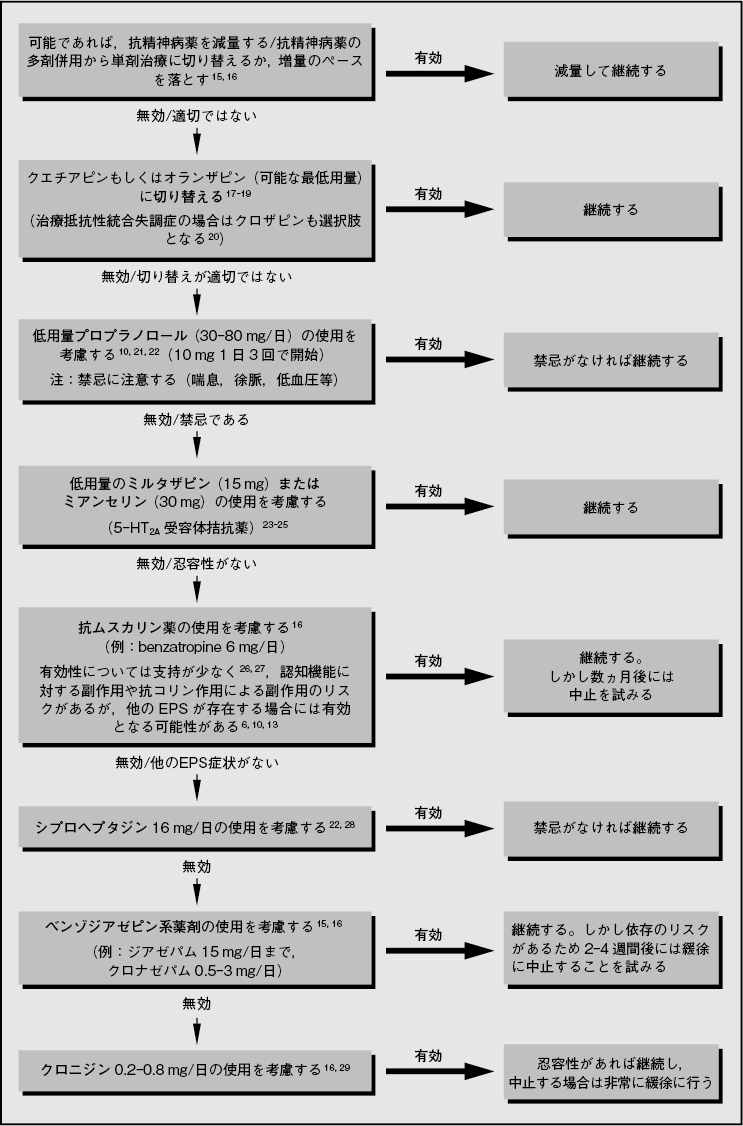アカシジア
アカシジアは大部分の抗精神病薬でよくみられる副作用であるが,最近承認された抗精神病薬のいくつかを含む特定のSGAは,アカシジアのリスクが低いと考えられる1, 2。3件の無作為化非盲検試験を対象としたプール解析では3,精神病初回エピソード(FEP)におけるアカシジアの発生率は,ハロペリドールで57%,リスペリドンで20%,アリピプラゾールで18%,ziprasidoneで17%,オランザピンで4%,クエチアピンで3.5%であった。lumateperoneとpimavanserinは数ヵ国でしか市販されていないが,予備的データから,lumateperoneはアカシジアのリスクが低いと考えられ4,pimavanserinはハロペリドール誘発性アカシジアを改善する可能性がある5ことが示唆されている。
アカシジアの主な特徴は,落ち着きのない感覚を特徴とする精神的不安および不快感である6, 7。通常,これに伴い運動不穏状態がみられ,重度になると,患者は行きつ戻りつしたり,短時間しか座っていられなくなったりすることもある6, 7。アカシジアにより患者が主観的に感じる不快と自殺念慮の関連が推定されているが8, 9,まだ不確実さが残る。
高用量の抗精神病薬,抗精神病薬の多剤併用,用量の急激な増量を避けることによってアカシジアを予防できる可能性があることを示唆するエビデンスがいくつか認められる6, 10-12。アカシジアのリスクが低い抗精神病薬への切り替え,またはβ遮断薬,5-HT2A受容体拮抗薬,抗コリン薬の追加等,よく行われるアカシジアの薬物療法でさえ,ベネフィット・リスクバランスについてはエビデンスがあまりない13, 14。次の図に,持続する薬剤誘発性アカシジアの治療選択肢プログラムを提案する。

(長井 信弘)
参照文献
- Demyttenaere K, et al. Medication-induced akathisia with newly approved antipsychotics in patients with a severe mental illness: a systematic review and meta-analysis. CNS Drugs 2019; 33:549–566.
- Chow CL, et al. Akathisia and newer second-generation antipsychotic drugs: a review of current evidence. Pharmacotherapy 2020; 40:565–574.
- Juncal-Ruiz M, et al. Incidence and risk factors of acute akathisia in 493 individuals with first episode non-affective psychosis: a 6-week randomised study of antipsychotic treatment. Psychopharmacology 2017; 234:2563–2570.
- Correll CU, et al. Efficacy and safety of lumateperone for treatment of schizophrenia: a randomized clinical trial. JAMA Psychiatry 2020; 77:349–358.
- Abbas A, et al. Pimavanserin tartrate: a 5-HT2A inverse agonist with potential for treating various neuropsychiatric disorders. Exp Opin Pharmacother 2008; 9:3251–3259.
- Braude WM, et al. Clinical characteristics of akathisia. A systematic investigation of acute psychiatric inpatient admissions. Br J Psychiatry 1983; 143:139–150.
- Barnes TRE. A rating scale for drug-induced akathisia. Br J Psychiatry 1989; 154:672–676.
- Seemuller F, et al. Akathisia and suicidal ideation in first-episode schizophrenia. J Clin Psychopharmacol 2012; 32:694–698.
- Seemuller F, et al. The relationship of akathisia with treatment emergent suicidality among patients with first-episode schizophrenia treated with haloperidol or risperidone. Pharmacopsychiatry 2012; 45:292–296.
- Miller CH, et al. Managing antipsychotic-induced acute and chronic akathisia. Drug Saf 2000; 22:73–81.
- Berardi D, et al. Clinical correlates of akathisia in acute psychiatric inpatients. Int Clin Psychopharmacol 2000; 15:215–219.
- Yoshimura B, et al. Incidence and predictors of acute akathisia in severely ill patients with first-episode schizophrenia treated with aripiprazole or risperidone: secondary analysis of an observational study. Psychopharmacology 2019; 236:723–730.
- Pringsheim T, et al. The assessment and treatment of antipsychotic-induced akathisia. Can J Psychiatry 2018; 63:719–729.
- Stroup TS, et al. Management of common adverse effects of antipsychotic medications. World Psychiatry 2018; 17:341–356.
- Fleischhacker WW, et al. The pharmacologic treatment of neuroleptic-induced akathisia. J Clin Psychopharmacol 1990; 10:12–21.
- Sachdev P. The identification and management of drug-induced akathisia. CNS Drugs 1995; 4:28–46.
- Kumar R, et al. Akathisia and second-generation antipsychotic drugs. Curr Opin Psychiatry 2009; 22:293–299.
- Miller DD, et al. Extrapyramidal side-effects of antipsychotics in a randomised trial. Br J Psychiatry 2008; 193:279–288.
- Rummel-Kluge C, et al. Second-generation antipsychotic drugs and extrapyramidal side effects: a systematic review and meta-analysis of head-to-head comparisons. Schizophr Bull 2012; 38:167–177.
- Kane JM, et al. Akathisia: an updated review focusing on second-generation antipsychotics. J Clin Psychiatry 2009; 70:627–643.
- Adler L, et al. A controlled assessment of propranolol in the treatment of neuroleptic-induced akathisia. Br J Psychiatry 1986; 149:42–45.
- Fischel T, et al. Cyproheptadine versus propranolol for the treatment of acute neuroleptic-induced akathisia: a comparative double-blind study. J Clin Psychopharmacol 2001; 21:612–615.
- Laoutidis ZG, et al. 5-HT2A receptor antagonists for the treatment of neuroleptic-induced akathisia: a systematic review and meta-analysis. Int J Neuropsychopharmacol 2014; 17:823–832.
- Poyurovsky M, et al. Mirtazapine – a multifunctional drug: low dose for akathisia. CNS Spectr 2011; 16:63.
- Poyurovsky M. Acute antipsychotic-induced akathisia revisited. Br J Psychiatry 2010; 196:89–91.
- Rathbone J, et al. Anticholinergics for neuroleptic-induced acute akathisia. Cochrane Database Syst Rev 2006; CD003727.
- Baskak B, et al. The effectiveness of intramuscular biperiden in acute akathisia: a double-blind, randomized, placebo-controlled study. J Clin Psychopharmacol 2007; 27:289–294.
- Weiss D, et al. Cyproheptadine treatment in neuroleptic-induced akathisia. Br J Psychiatry 1995; 167:483–486.
- Zubenko GS, et al. Use of clonidine in treating neuroleptic-induced akathisia. Psychiatry Res 1984; 13:253–259.
- Gervin M, et al. Assessment of drug-related movement disorders in schizophrenia. Adv Psychiatr Treatment 2000; 6:332–341.
- Cunningham Owens DA. Guide to the extrapyramidal side effects of antipsychotic drugs. Cambridge University Press; 1999.
- Miodownik C, et al. Vitamin B6 versus mianserin and placebo in acute neuroleptic-induced akathisia: a randomized, double-blind, controlled study. Clin Neuropharmacol 2006; 29:68–72.
- Lerner V, et al. Vitamin B6 treatment in acute neuroleptic-induced akathisia: a randomized, double-blind, placebo-controlled study. J Clin Psychiatry 2004; 65:1550–1554.
- De Berardis D, et al. Reversal of aripiprazole-induced tardive akathisia by addition of pregabalin. J Neuropsychiatry Clin Neurosci 2013; 25:E9–E10.
- Friedman BW, et al. A randomized trial of diphenhydramine as prophylaxis against metoclopramide-induced akathisia in nauseated emergency department patients. Ann Emerg Med 2009; 53:379–385.
- Stryjer R, et al. Trazodone for the treatment of neuroleptic-induced acute akathisia: a placebo-controlled, double-blind, crossover study. Clin Neuropharmacol 2010; 33:219–222.
- Gross-Isseroff R, et al. The 5-HT1D receptor agonist zolmitriptan for neuroleptic-induced akathisia: an open label preliminary study. Int Clin Psychopharmacol 2005; 20:23–25.
- Avital A, et al. Zolmitriptan compared to propranolol in the treatment of acute neuroleptic-induced akathisia: a comparative double-blind study. Eur Neuropsychopharmacol 2009; 19:476–482.
- Erdur B, et al. A trial of midazolam vs diphenhydramine in prophylaxis of metoclopramide-induced akathisia. Am J Emerg Med 2012; 30:84–91.

